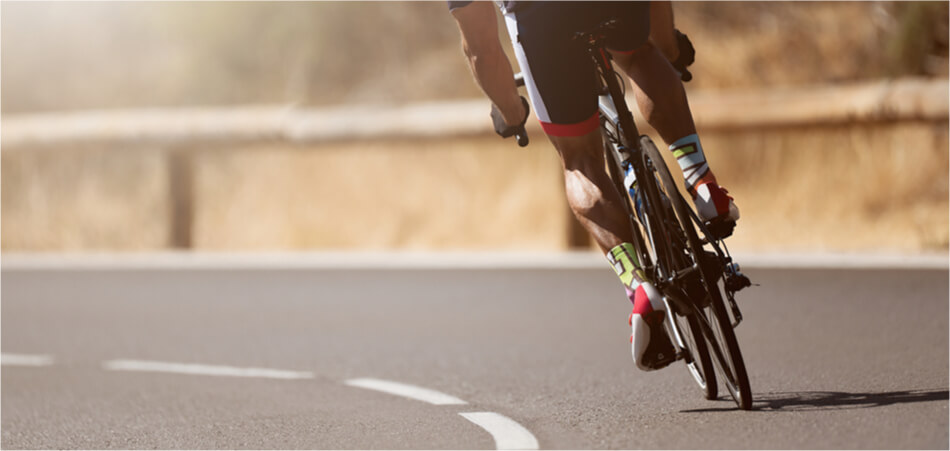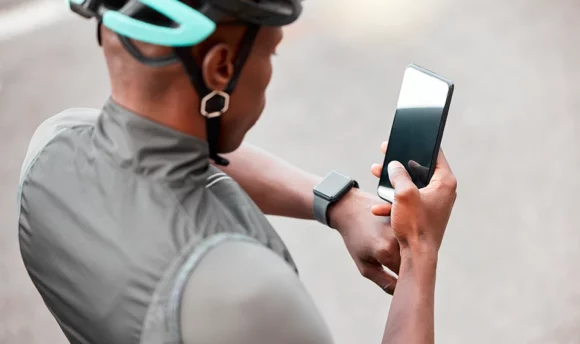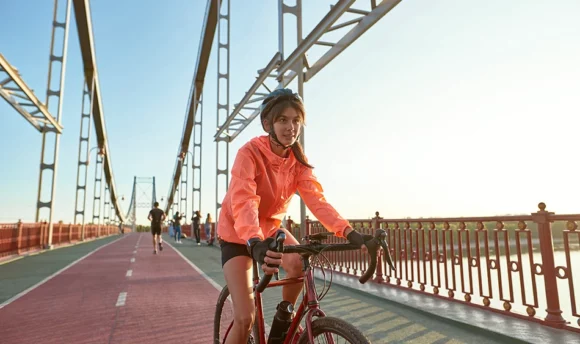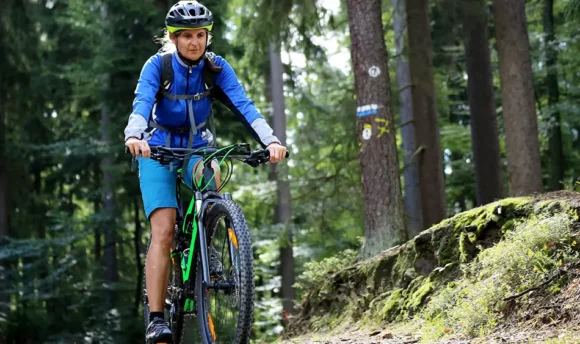What Muscles Groups Work During Cycling and How to Train Them
Cycling is a great way to train major muscle groups and build a toned body. Learn what muscles work while biking and how to train them.

The experts from the U.S. Department of Health and Human Services highlight that a minimum of 150 minutes of moderate-intensity physical activity per week is essential for all adults.
Cycling is a great exercise that can be beneficial to both beginners and professionals. You can bike indoors in the gym or enjoy the fresh air outside on your way to work or in a beautiful park.
This physical activity not only builds great cardiovascular endurance but can also help you strengthen your lower body and engage some muscles in the upper body, namely core muscles and arms.
Learn more about what muscles cycling works, discover how to improve muscle gain, and read some pro tips from the coach.
What Muscles Does Cycling Work? – Primary Muscle Groups Used in Cycling
Cycling engages many muscles, particularly those in the lower body and some muscle groups in the arms and shoulders. Let’s take a closer look at each muscle group that is trained the most during cycling.
Calf
Calves are the muscles that help you recognize a cyclist: they are generally more defined and are larger than those of the average person. Among the calf muscles, soleus and gastrocnemius get pumped during cycling: the first one lifts the hill during the pedal stroke, and the latter allows cyclists to move.
Thigh
The hamstrings and quadriceps are the most active upper leg muscles: they help bring one leg up and push the pedal down respectively. The quads are the second most engaged muscles after calf muscles.
Glutes
Gluteal muscles, otherwise known as buttocks, consist of the gluteus maximus, medius, and minimus. The three of them cooperate with the hips to make a rotating movement. The gluteus maximus is most engaged during the pedal stroke when you are pressing the pedal down and when you are seated rather than standing.
Arms
Arm muscles, in particular biceps and triceps, take part in the process as well since they help you grip the bicycle. It is not enough engagement to gain a lot of muscles, but they can become a little bit better defined.
Shoulders
In the shoulders, deltoids are key muscle groups used during cycling. Sometimes it can even lead to shoulder pain if you do not change poses occasionally.
Core
The core, especially the upper and lower abs, is engaged to help you balance on the bike. Noticeably, the upper body works much more when you are on the bike outdoors rather than while using gym equipment since you do not need to stabilize yourself in the second case. Thus, riding a bike doesn’t only help you build muscles but also effectively burns belly fat.
Foot
In the foot, plantar flexors and dorsiflexors allow you to move the heel up and down to complete a pedal stroke.
How to Improve Muscle Gain While Cycling?
Muscle gain can take quite a while, but if you know how to cycle effectively and think about muscle gain as a complex of activities, you can see the result much earlier. A well-balanced diet and regular exercise can get your primary muscles toned much faster and help you avoid bulging calf muscles.
Here are some tips to help you gain muscle while cycling:
Keep track of your nutrition
Nutrition is a vital part of gaining muscles during cycling, but many cyclists ignore it. You can bike as much as you want, but if you choose to eat only chocolates and fast food in between, you may notice how you gain muscles and strength, but it is all hidden behind fat that does not go anywhere.
As a result, you may think that you even gained weight because of cycling rather than lost it. In order to make lower body muscles well-defined and visible, it is important to have a balanced diet.
A good diet for muscle gain includes a lot of proteins, healthy fats, and whole foods. You can get those from the following products: meat, dairy, fish, eggs, grains, seeds, beans, lentils, nuts, fruits, and vegetables.
If you are experiencing trouble with getting all your healthy and strengthening elements from food, you can also turn to supplements. Just make sure to follow the main tips for supplement users outlined by the FDA.
Careful nutrition also includes drinking a lot of water since it transports all the nutrients where they are needed. It is also recommended to eat smaller portions but more often, and preferably not skipping breakfast.
It goes without saying that binging on fast food and fast carbs very often will not do you well either: try to avoid burgers and fries, chocolates and candy, chips, cakes, and the likes. However, if you want to have some carbs, you can enjoy them right before a good workout.
Do additional exercises to build strength
Additional exercises for different muscle groups have three main benefits for cyclists:
- You will get into cycling much easier.
- You will gain muscle mass faster.
- You will gain muscle more proportionally.
It is difficult to go for long distances when you have never biked before, but exercise can help you get accustomed much faster and safer so that you can go as far away from the city as you want to.
Sweating doesn’t necessarily indicate losing weight. Thus, you need additional training to help you eliminate fat and engage all the muscles so that you do not have amazing calves paired with an untrained core and weak hands.
If you want to train your lower body for easier cycling, you can try lunges, squats, single-leg bridges, and leg lifts.
For core strength and, consequently, better balance on the bike, you can try elbow to tall plank, swimmers, boat pose, and the low row. The shoulders and hands are also important to train and stretch to avoid pains from cramps. You can go for shrugs, lateral raises, upright rows, and pushups.
You can do stationary bike workouts on major muscle groups such as bicep curls, skull crushers, or ab twists even while on the bike inside the gym.
At the same time, every person will need a different approach, especially in meals, based on their gender, lifestyle, fitness goals, levels of previous physical activity, and diet restrictions.
A Word From Our Coach
Cycling is low-impact cardio, but because of the resistance component, it can become a major muscle growth activity. You only need to comprehend the realistic outcome of your efforts to avoid being quickly demotivated and to engage in other physical activities to avoid having a disproportionate physique.
You can expect growth in the calf muscles and above the knee, as well as toned buttocks. However, If you just casually pedal stroke on the weekend or on your way to work, you are likely to get toned only and improve your overall endurance.
It is not a bad result; such consequences are great for your overall well-being and long-term health. However, for more visible results, you will have to either bike for long periods or do some additional training with weight lifting.
If you boost the resistance element in cycling, you will also be surprised by how much faster you improve. Choose paths with as many hills as possible or shift to the higher gear to do so.
You may also notice that your quadriceps get stronger faster than the hamstring muscles that work the knee. Therefore, it is also recommended to do knee flexion exercises to correct muscle imbalances and knee pain.
Conclusion
As you’ve already learned, regular cycling is a very beneficial activity for muscle growth. The position you take matters as well. For example, when you are riding hand-free, you will engage your core much more but have no arms and shoulder training.
You can also stand up to the pedal to add more resistance to the upstroke and more weight on your downstroke. While seated, you will mostly engage the quadricep muscles, calves, and glutes, and standing pedaling will engage hamstrings and hip flexors, as well as boost the engagement of the calves. It is better to switch positions periodically to engage all kinds of muscles.
The speed can work your muscles more as well. The slower you go, the more muscles work, rather than the momentum of the pedal and chain. It is better to cycle this way on a flat surface. Going up a hill slowly will make you extra tired very soon, bringing little satisfaction.
Overall, it is likely that the appearance of the muscles will change. As you experience weight loss during cycling and the proper diet, the muscles will become more evident and shaped.

















































 Select your language:
Select your language: 








